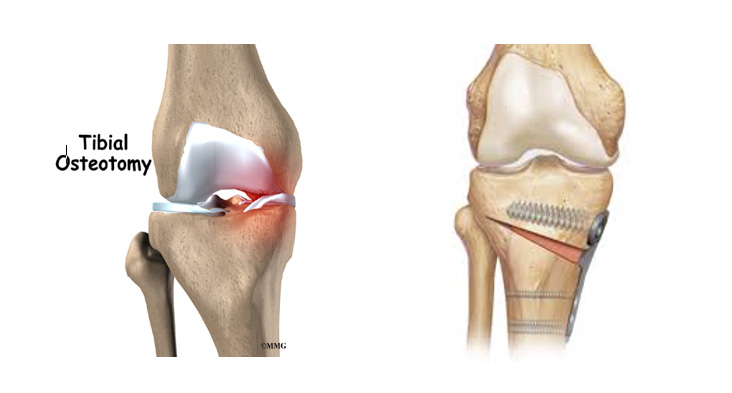- Home
- Tibial Osteotomy
Tibial Osteotomy
What is High Tibial Osteotomy?
A high tibial osteotomy is a surgical procedure that realigns the knee joint by correcting the deformity in the proximal tibia in partial knee arthritis.
When do you require high tibial osteotomy
If you are suffering from severe pain either on medial (inner) or lateral (outer) side of your knee limiting your activities you might be suffering from partial knee arthritis (one compartment). When the severe arthritis is limited to one compartment, high tibial osteotomy is also a good option

What are the knee compartments?
Your knee joint is divided into three compartments, medial compartment (the inside part of the knee), lateral compartment (the outside part) and patellofemoral compartment (the front of the knee between the kneecap and thighbone)
What are the advantages of hgh tibial osteotomy surgery?
This surgery can delay or prevent the need for a partial or total knee replacement by preserving damaged joint tissue. There are no restrictions on physical activities. You can resume all normal activities
By shifting the body weight from the damaged side of the joint to the normal side, an osteotomy can relieve pain and significantly improve function in an arthritic knee
BOOK AN APPOINTMENT
“KNEEO Technique” For Knee Replacements
Tibial Osteotomy
- Tibial osteotomy attempts to restore the proper mechanical axis of the knee. The ideal patient for osteotomy has single-compartment disease and ligamentous stability and is young and physically active.
- The goal of realignment osteotomy is to redistribute the forces through the knee from the diseased compartment to the compartment with better articular cartilage. Good to excellent results with tibial osteotomy are reported to range from 73% to 95% at 5 years. Ten-year results are less impressive, with a range from 45% to 80% (Billings et al. 2000, Coventry et al. 1993).
- Absolute contraindications include inflammatory arthritis, tricompartmental disease, flexion arc less than 90 degrees, tibiofemoral subluxation, and previous meniscectomy in the contralateral compartment.
- Relative contraindications include age older than 60 years, patellofemoral disease, ligamentous instability, lateral tibial subluxation, or a varus deformity greater than 10 degrees.
- Varus deformities are corrected with a lateral closing wedge. For large varus deformities, a tibiofemoral angle greater than 12 degrees, a dome osteotomy may be more appropriate.
- A medial closing wedge may be used to correct a mild valgus deformity, an angle less than 12 degrees.
- Larger valgus deformities may require a distal femoral osteotomy to maintain the joint line and to prevent tibial subluxation. Internal fixation allows for early range of motion and weight bearing (Healy et al. 1998).
- Complications associated with tibial osteotomy include infection (higher rates when external fixators are used), peroneal nerve palsy, undercorrection, nonunion, overcorrection, and compartment syndrome postoperatively.
- It is very important to perform the osteotomy at least 2 cm below the joint line to prevent fracture through the proximal fragment and extension into the joint space. TKA following tibial osteotomy can be difficult. The lateral plateau may be deficient and may require an augment. If a stemmed tibial component is to be used, an offset stem may be required to ensure passage down the canal (Meding et al. 2000, Naudie et al. 1999).


